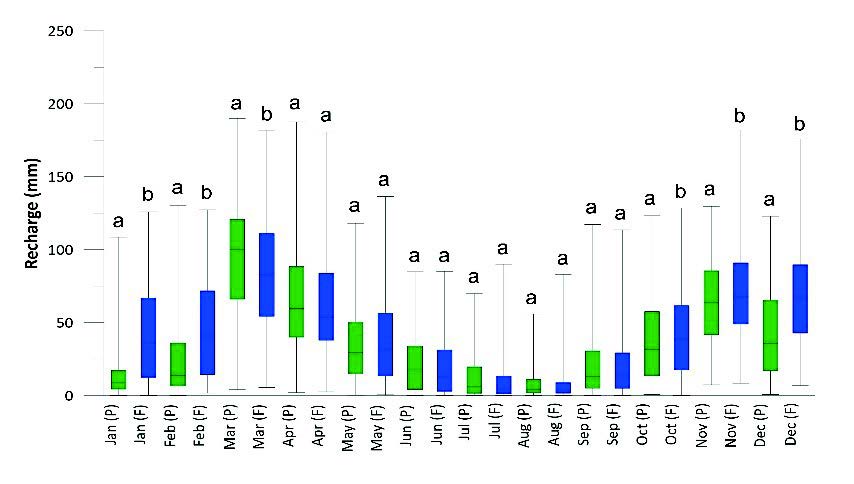Groundwater use for agricultural production - current water budget and expected under climate change
This project highlights the importance for water users to prepare for prolonged dry periods during the growing season, which could lead to increased irrigation needs, especially when recharge is already extremely low.
Project details
Principal(s) investigator(s)


Context
In many Canadian provinces, groundwater is a critical resource for agricultural production, including activities such as irrigation and livestock watering, and for potable water supply through individual or municipal wells. When there is not enough water available in a given hydrosystem, various issues can occur surrounding competing uses.
In southern Ontario, population growth and the intensification of agriculture have created increasing pressure on water supply, which is being exacerbated by climate change.
Objective(s)
Examine future groundwater availability at a subwatershed scale (Lower Whitemans Creek in southwestern Ontario) in an area dominated by agricultural use where there is water use conflict.
Methodology
-
Instrumentation of the study site for long-term monitoring of groundwater levels;
-
Field work and data analysis to quantify the water budget of the study site;
-
Construction and calibration of a fully coupled model (SWAT-MODFLOW) for current and recent conditions;
-
Analysis of climate change scenarios for precipitation and temperature;
-
Simulation of past and future conditions to estimate possible changes in surface flow and groundwater flow for ten scenarios.
Results
The analysis of past and future hydrological conditions showed that future annual recharge could increase, potentially providing an opportunity for increased water use. However, as the subwatershed is already water-stressed, some challenges may occur during peak periods (summer) when agricultural needs are high. The main conclusions are as follows:
Water deficits (P-ETP<0) have been observed for several years and current permitted pumping is similar in magnitude to the average past recharge. These water deficits could lead to increased irrigation and pose issues or conflicts for future water takings, at times when demand is highest while availability is lowest. The permitted water takings appear to be much higher than the declared ones. There is clearly a need to determine more precisely how much water is actually pumped in order to ensure optimal water management.
The ten climate scenarios used indicate the following mid-century future conditions for the study area: increase in average annual temperature between 1.2 and 4,0°C, and increase in precipitation between 12 and 181 mm/year compared to 1971-2000. This corresponds to an increase in ETP of between 36 and 149 mm/year, and a change in net precipitation (P - ETP) between -100 mm/year (reduction mainly during the summer growing season) and +53mm/year.
Overall, the simulations show higher annual recharge for the future conditions (past median recharge of 443 mm/year and future median recharge of 524 mm/year), but this recharge will be distributed differently throughout the year. There will be more recharge in the fall (greater precipitation) and from December to February (milder winters with less snow), while recharge in March will be lower (less snow during the spring snowmelt period).
From April to September, past and future simulations show no significant difference in recharge (Figure 1). While future climate conditions do not indicate an overall reduction in the rate of groundwater turnover, prolonged dry periods during the growing season, when recharge is already extremely low, could result in increased irrigation requirements.

Figure 1: Simulated monthly recharge for the reference period (green; 1971-2000) and for the future horizon (blue; 2041-2070)
In conclusion, current permitted water takings may not be sustainable into the future in small subwatersheds like Lower Whitemans Creek with highly permeable soils, stresses on current water availability and dense agricultural activities. Predictive models are needed to simulate future water budgets (including the impacts of climate and land use change) to ensure that collective uses of water resources do not have adverse impacts on available water supply in the years and decades to come.
Benefits for adaptation
Benefits for adaptation
It appears important for water users to prepare for prolonged dry periods during the growing season, which could lead to increased irrigation needs, especially when recharge is already extremely low.
The results have been presented to water resource managers who can use them to better plan permitted pumping rates and target watersheds where there is a need for long-term monitoring of all components of the water budget.
Long-term monitoring of all components of the water budget is needed across high water use watersheds to support holistic water management. Local, provincial and federal efforts in this regard are of critical importance.
Scientific publications
Funding


Other participants
-
Grand River Conservation Authority
-
Ministry of the Environment, Conservation and Parks
-
Ontario Federation of Agriculture
-
Ministère de l'Environnement et de la Lutte contre les changements climatiques